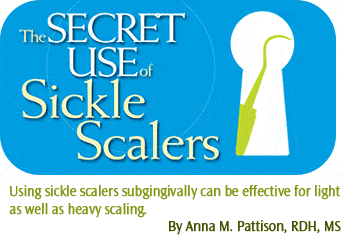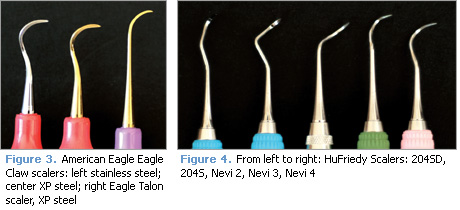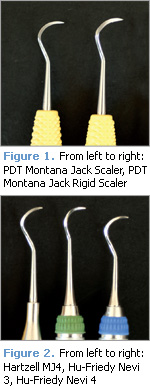
The Secret Use of Sickle Scalers
Using sickle scalers subgingivally can be effective for light as well as heavy scaling.
The subgingival use of sickle scalers may be the best kept secret of dental hygiene practice. Most clinicians were taught to use sickles only supragingivally for gross calculus removal. It is not unusual, however, for many experienced clinicians to use all types of sickle scalers subgingivally for light as well as heavy scaling.
During my lectures on periodontal instrumentation, I routinely ask audience members questions about sickle scalers. First, I ask them to raise their hands if they were taught to use sickle scalers only supragingivally. Almost all raise their hands. Next, I ask how many now use sickle scalers subgingivally. At least 90% raise their hands and begin to laugh. Then, I ask if they use these sickles subgingivally as deep as they can possibly get them without traumatizing the tissue. Again, over 90% raise their hands and filled the room with loud laughter. So why are we all sneaking around in the secrecy of our operatories using sickles and hoping that no one will catch us?
Experience Required
The truth is that the prohibition of subgingival scaling with sickles is probably based on instructors’ fears that students lack the skill to keep the sickle blade properly adapted to the tooth. Excellent knowledge of root morphology and clinical experience are required to develop the ability to visualize the position of the sharp point of this potentially dangerous instrument, especially as it approaches the soft tissue attachment.
Once they gain this experience, many dental hygienists and dentists begin to use sickle scalers subgingivally because they discover that sickles can be more efficient at removing heavy calculus than curets. Therefore, many experienced clinicians routinely use sickle scalers first for heavy scaling or follow initial subgingival ultrasonic scaling with sickle scalers before finishing with universal or Gracey curets.
The Efficacy of Sickle Scalers
Sickles are effective because the sharp cutting edge of the sickle is adapted to heavy or tenacious calculus at a more open angle (80° to 90°) than a curet. This angulation allows the strong sickle scaler blade to fracture the deposit cleanly away from the tooth. The calculus often breaks away from the tooth in visible chunks or pieces rather than being shaved or whittled away, layer by layer, from the tooth.
Universal and Gracey curets tend to shave away or burnish heavy or tenacious calculus when they are used improperly with the blade too closed at less than a 70° angle. On the proximal surfaces of molars, the acutely angled shanks of posterior sickles allow the blades to engage the calculus with a more open angle than a Gracey curet.
Anterior straight shanked sickles such as the H6/7, H5/33, or the J34/35 Jacquette are commonly used subgingivally on the mandibular anterior teeth. Although it is possible for anterior sickles to be used subgingivally on the posterior teeth if skillful extraoral or opposite arch rests are used, it is still better to use a double ended posterior sickle such as a 204S, 204SD, or the J31/32 Jacquette. These sickles are specifically designed for premolars and molars so they are safer and more efficient for subgingival calculus removal on the posterior teeth.
Historically, most schools have issued a double ended posterior Jacquette sickle scaler such as the J31/32 or a double ended curved posterior sickle scaler such as the 204S. In recent years, several companies have introduced new posterior sickle designs that are becoming very popular in the United States and Canada.
Instruments on the Market
Paradise Dental Technologies (PDT) (Missoula, Mont) introduced the original Montana Jack scaler, a double ended, curved posterior sickle scaler in 2001. With a light, tactilely sensitive plastic handle and curved, mirror image blades, this scaler became a favorite of dental hygienists who were searching for a thin, sharp scaler to use on patients with light to moderate calculus. In 2007, PDT, began to produce a new Rigid Montana Jack for heavier scaling that has larger shanks with blades that are as narrow as the original Montana Jack but thicker face to back (Figure 1).
G. Hartzell & Sons (Aptos, Calif) also produces a similar curved posterior sickle with a large hollow metal handle. The Hartzell MJ4 scaler is double ended with rigid, large, strong, curved blades that are ideal for scaling moderate to heavy subgingival calculus (Figure 2). American Eagle Instruments Inc (Missoula, Mont) makes a posterior sickle called the Eagle Claw that is available in either stainless steel or XP™ steel, which never needs sharpening. The company also offers a companion anterior sickle called the Eagle Talon that has a Nebraska 128 blade on one end and a Jacquette on the other (Figure 3).

The newest curved posterior sickle scalers on the market are the Nevi 3 and Nevi 4 scalers (Hu-Friedy Mfg Co, Chicago). Hu-Friedy introduced the Nevi 1 and Nevi 2 scalers in 2001. The Nevi 1 anterior sickle scaler has a modified H6 blade on one end and a spoon excavator like chisel on the other end for removal of supragingival calculus and stain primarily from the lingual surfaces of the maxillary and mandibular anterior teeth. The Nevi 2 is a double ended acutely curved posterior sickle that is very thin. The extreme 90° curvature of the Nevi 2 shank extreme curvature promotes neutral wrist position but limits it to supragingival scaling or subgingival scaling only a few millimeters below the margin.
The new Nevi 3 is a modification of the Wiland Carver that was originally designed as a restorative finishing instrument. Its thin curved blades make it very useful for light to moderate scaling in shallow to moderate depths. The Nevi 3 is also excellent for scaling of malpositioned teeth and for scaling pediatric patients. The new Nevi 4 is a modified Montana Jack design that has open angled shanks with wider, strong, curved blades that are designed for moderate to heavy scaling. The Nevi 4 is more rigid than either the Nevi 2 or the Nevi 3 (Figure 4). All of these Nevi scalers can be obtained in EverEdge® metal with large, hollow metal handles.
The strength and efficiency of sickle scalers have made them universally popular. New posterior sickle designs now provide clinicians with better choices for initial scaling but they should always be followed by curets to complete definitive instrumentation.
From Dimensions of Dental Hygiene. September 2008; 6(9):44, 46-47.


